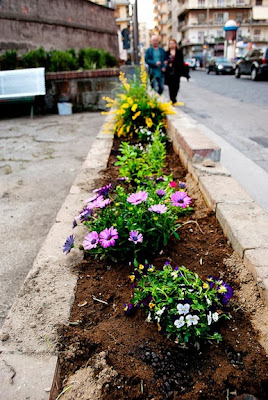Reuters. Feral cat in Beijing. From theatlanticcities.com
I´ve been writing about animals in the city, specially about our pigeons´ plague in Buenos Aires, a nightmare because of the diseases they carry with them. And they are really lovely....
Seven years ago, I was reading at L.A. Times on the squirrels in California mountains, one of the journalists was declaring himself a killer of squirrels, given they ate his subterranean cables, ate the trash, ate everything they could find at his home. They are beautiful, but they are a kind of rat, right?
At the same time, I was reading about ravens in southern CA. I see them everywhere here, being friends with seagulls. Main reason for all these animals reproduction: food, in the alleys, lots of food.
Another animal in SoCal which wasn´t urban but now is ¨friendly¨ with humans: the coyote. ¨Friendly¨ at a certain point, because they eat pets. People call the Sanitary department, whichever, City Hall, Health Department, Pest control, Animal control, ....and the answer is always the same: if the animal is not dangerous for humans, what can they do? Of course, you´d never leave your baby or kid outdoor, alone, in danger of meeting a coyote.
Today, I was reading about feral cats in Beijing. And please, note the difference. Feral is not a synonymous of ¨stray¨. A stray one could be an abandoned or lost domestic cat. Feral means ¨wild¨ with all the implications of the word.
A popular and brazen coyote that was frequently seen cavorting and hunting in close proximity to people at Huntington Beach's Central Park was euthanized on June 21. This photo was taken by Dawn Macheca of Huntington Beach about two weeks before the animal was darted and then put down by O.C. Animal Control.
Can people live with so many animals around? It was a problem of consideration in Medieval Times: ¨In the twelfth century, half the householders of Paris kept pigs which roamed the streets in search of provender. As unofficial refuse collectors, they were invaluable, tut they tended to trip up pedestrians and tangle up traffic. After the heir to the throne had fractured his skull when a pig ran between his horse´s legs, an edict was issued that there should be no more pig-rearing in towns.¨
Believe it or not, we still have this animal issue, let´s see what happens in Beijing with (thousands, millions???) feral cats:
Beijing has never been overly sympathetic to the plight of stray cats, famously rounding up thousands of the creatures – both feral and abandoned – in preparation for the 2008 Summer Olympics (it also shut down factories, shipped homeless people away, and limited the number of cars driving into the city). It’s still not clear whether those cats were euthanized or simply died from disease in shelters, but they were gone.
Four years later, the cats are back. The Chinese are deep into a love affair with domestic animals, creatures that they are reluctant to spay or neuter, says Mary Peng, co-founder of the International Center for Veterinary Services in Beijing. Perhaps it’s a small act of resistance in a country that limits the reproductive rights of its human population, but China does not have the tradition of neutering pets that pet owners in the United States take for granted. And just one female cat can have as many as three or four litters a year, ultimately adding another 100 cats to the feral population in its lifetime.
Peng, a Chinese-American native New Yorker who has lived in Beijing for the last 20 years, has taken on the mission of convincing Beijing’s residents that the best solution to the feral cat population is a program called “trap, neuter, release,” or TNR. The philosophy behind the program is that trapping the animals, fixing them so that they can’t reproduce, and then returning them to their established colony is a better solution than exterminating cats or trying to find them domestic homes.
But the program is controversial. Some ecologists argue that feral cats are so terrible for urban ecosystems, capable of killing off whole species of native wildlife, that they really ought to be euthanized. And groups like the Audubon Society claim that TNR has not proven to be effective in eliminating the population of feral cats anywhere.
Read the article in full:











































